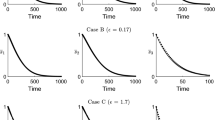Abstract
Substrate cycles are ubiquitous structures of the cellular metabolism (e.g. Krebs cycle, fatty acids β-oxydation cycles, etc... ). Moiety-conserved cycles (e.g. adenine nucleotides and NADH/NAD, etc...) are also important.
The role played by such cycles in the metabolism and its regulation is not clearly understood so far. However, it was shown that these cycles can generate multistationarity (bistability), irreversible transitions, enhancement of sensitivity, temporal oscillations and chaotic motions (Hervagault & Canu, 1987; Hervagault & Cimino, 1989; Reich & Sel'kov, 1981; Ricard & Soulié, 1982). Fig. 1: Scheme of the open binary substrate cycle under study. The substrate S is converted into P with a net rate v2. Substrate P is converted in turn into S with a net rate v3. Step v2 is inhibited by excess of the substrate, S. In addition, the cycle operates under open conditions, that is zero-order input of S at rates \ga0(v1) and first order outputs of S and P at rates \gaS and \gaP(v4), respectively.
The metabolic control theory (see also Fell, 1990), which shows how a metabolic network reacts to small perturbations in the vicinity of a steady state, and is formulated with the so-called “control coefficients”, was applied to such a cycle in order to get a better knowledge on the importance of each step at the regulatory point of view.
The behaviour of a binary substrate cycle (fig. 1) in which one of the enzymes may be subjected to inhibition by excess of its substrate (v2) was studied theoretically. The flux and concentration control coefficients were calculated for various steady states of the system. The evolution of the different control coefficients is compared to the evolution of the steady states. We mainly focused our study on situations for which the steady states are stable.
Similar content being viewed by others
References
Fell, D.A. (1990). Substrate cycles. Theoretical aspects of their role in metabolism. Comments on Theoretical Biology 6: 1–14.
Hervagault, J.F. & S. Cann (1987). Bistability and irreversible transitions in a simple substrate cycle. J. Theor. Biol. 127: 439–449.
Hervagault, J.F. & A. Cimino (1989). Dynamic behaviors of an open substrate cycle: A graphical approach. J. Theor. Biol. 140: 399–416.
Letellier, T., C. Reder & J.P. Mazat (1991). Control: Software for the analysis of the control of metabolic networks. Comp. Appl. Biosci. 7: 383–390.
Reich, J.G. & E.E. Sel'kov (1981). Energy Metabolism of the Cell: A Theoretical Treatise. London, Academic Press.
Ricard, J. & J.M. Soulié (1982). Self-organization and dynamics of an open futile cycle. J. Theor. Biol. 95: 105–121.
Author information
Authors and Affiliations
Rights and permissions
About this article
Cite this article
Fassy, F., Hervagaule, JF., Letellier, T. et al. Application of the metabolic control theory to the study of the dynamics of substrate cycles. Acta Biotheor 40, 121–129 (1992). https://doi.org/10.1007/BF00168141
Published:
Issue Date:
DOI: https://doi.org/10.1007/BF00168141




